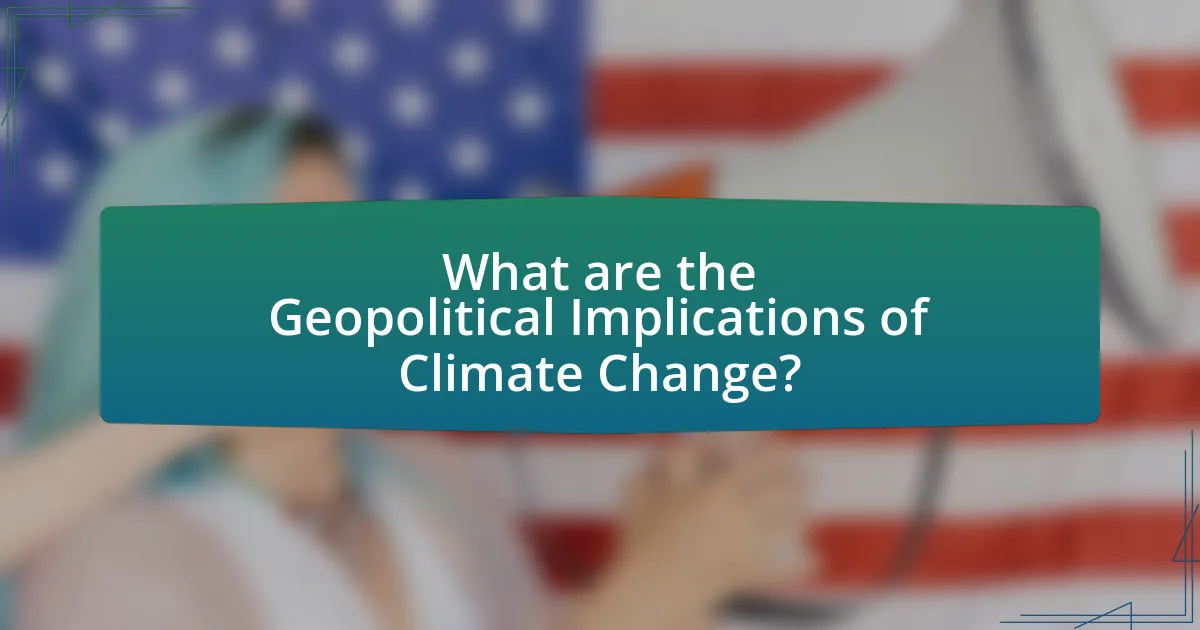The article examines the geopolitical implications of climate change, highlighting its effects on resource competition, migration patterns, and national security risks. It discusses how climate change exacerbates resource scarcity, alters global power dynamics, and increases geopolitical tensions, particularly in vulnerable regions such as Sub-Saharan Africa and South Asia. The article also addresses the role of international agreements in mitigating these risks, the economic consequences of climate change on global trade patterns, and strategies nations can employ to enhance resilience and cooperation in the face of climate challenges.

What are the Geopolitical Implications of Climate Change?
Climate change has significant geopolitical implications, including increased resource competition, altered migration patterns, and heightened national security risks. As global temperatures rise, regions such as the Arctic are becoming more accessible, leading to disputes over territorial claims and resource extraction, particularly oil and gas. For instance, the melting ice in the Arctic has prompted countries like Russia and Canada to assert their sovereignty over these areas, escalating tensions. Additionally, climate change is expected to displace millions of people, creating climate refugees who may seek asylum in more stable regions, potentially leading to political instability and conflict. The U.S. Department of Defense has identified climate change as a “threat multiplier,” indicating that it exacerbates existing vulnerabilities and can lead to increased violence and instability in already fragile states.
How does climate change affect global power dynamics?
Climate change significantly alters global power dynamics by exacerbating resource scarcity, leading to geopolitical tensions and shifts in alliances. As climate change impacts agriculture, water supply, and energy resources, nations that are less affected may gain leverage over those facing severe shortages. For instance, the 2011 Arab Spring was partly fueled by droughts in Syria, which intensified social unrest and contributed to the conflict. Additionally, countries with advanced technology and infrastructure for climate adaptation, such as the United States and European nations, may strengthen their global influence, while developing nations may struggle, potentially leading to increased migration and regional instability. This shift in power can result in new alliances and conflicts, as nations navigate the challenges posed by climate change.
What regions are most vulnerable to climate change impacts?
The regions most vulnerable to climate change impacts include Sub-Saharan Africa, South Asia, and the Arctic. Sub-Saharan Africa faces severe droughts, food insecurity, and health risks due to rising temperatures and changing precipitation patterns. South Asia is at risk from increased flooding, heatwaves, and sea-level rise, affecting millions of people living in coastal areas. The Arctic is experiencing rapid ice melt, which contributes to global sea-level rise and disrupts local ecosystems. These vulnerabilities are supported by reports from the Intergovernmental Panel on Climate Change (IPCC), which highlight the disproportionate effects of climate change on these regions due to their socio-economic conditions and reliance on climate-sensitive resources.
How do resource scarcity and climate change influence geopolitical tensions?
Resource scarcity and climate change significantly heighten geopolitical tensions by exacerbating competition for limited resources and creating instability in vulnerable regions. For instance, as freshwater supplies dwindle due to climate-induced droughts, countries sharing water sources, like the Nile Basin nations, face increased disputes over access and rights. Additionally, climate change can lead to food shortages, prompting migration and straining relations between nations, as seen in the Syrian conflict where drought contributed to social unrest. The U.S. Department of Defense has identified climate change as a “threat multiplier,” indicating that it intensifies existing vulnerabilities and conflicts, thereby increasing the likelihood of geopolitical strife.
What role do international agreements play in addressing climate change?
International agreements play a crucial role in addressing climate change by establishing binding commitments and frameworks for countries to reduce greenhouse gas emissions. These agreements, such as the Paris Agreement, facilitate cooperation among nations, promote accountability, and provide mechanisms for financial and technological support to developing countries. For instance, the Paris Agreement aims to limit global warming to well below 2 degrees Celsius, with countries submitting nationally determined contributions (NDCs) to outline their emission reduction targets. This collective approach is essential for achieving global climate goals, as individual nations often lack the capacity to tackle climate change effectively on their own.
How effective are current treaties in mitigating geopolitical risks?
Current treaties are moderately effective in mitigating geopolitical risks, particularly those related to climate change. For instance, the Paris Agreement aims to limit global warming and has led to commitments from nearly 200 countries to reduce greenhouse gas emissions. However, the effectiveness is often hindered by non-binding targets and varying levels of commitment among nations, as evidenced by the fact that many countries are not on track to meet their emissions goals. Additionally, geopolitical tensions can arise from resource scarcity exacerbated by climate change, which treaties alone may not fully address. Thus, while treaties provide a framework for cooperation, their impact on geopolitical stability is limited by enforcement challenges and differing national interests.
What are the challenges in enforcing climate agreements among nations?
Enforcing climate agreements among nations faces significant challenges, primarily due to differing national interests and economic priorities. Countries often prioritize immediate economic growth over long-term environmental commitments, leading to reluctance in adhering to agreements. For instance, developing nations may argue that stringent climate policies hinder their economic development, while developed nations may struggle with domestic political opposition to climate initiatives. Additionally, the lack of a binding enforcement mechanism in many agreements, such as the Paris Agreement, complicates compliance, as nations can opt out without facing penalties. Historical examples, like the failure of the Kyoto Protocol to achieve its targets, illustrate the difficulties in achieving collective action on climate change.
How does climate change impact national security?
Climate change significantly impacts national security by exacerbating resource scarcity, increasing the frequency of natural disasters, and driving mass migration. These factors can lead to heightened tensions between nations, as competition for dwindling resources such as water and arable land intensifies. For instance, the U.S. Department of Defense has identified climate change as a “threat multiplier,” indicating that it can worsen existing vulnerabilities and conflicts. Additionally, the National Intelligence Council’s Global Trends report highlights that climate-related disasters could displace millions, creating humanitarian crises that challenge national and international stability.
What are the potential threats to national security posed by climate change?
Climate change poses several potential threats to national security, including increased resource scarcity, heightened geopolitical tensions, and the exacerbation of natural disasters. Resource scarcity, particularly in water and food supplies, can lead to conflicts between nations and within regions, as seen in areas like the Middle East where drought has intensified competition for limited resources. Additionally, climate change can destabilize governments, as evidenced by the Syrian civil war, which was influenced by prolonged drought and agricultural collapse. The rise in frequency and severity of natural disasters, such as hurricanes and wildfires, can overwhelm national response capabilities and divert resources from other security priorities, further straining national security frameworks.
How can countries prepare for climate-induced migration?
Countries can prepare for climate-induced migration by developing comprehensive policies that address the anticipated influx of displaced populations. These policies should include establishing legal frameworks for migrants, enhancing infrastructure in receiving areas, and investing in climate resilience measures to mitigate the impacts of climate change. For instance, the United Nations High Commissioner for Refugees (UNHCR) emphasizes the need for countries to create pathways for safe and dignified migration, which can help manage the challenges posed by climate-related displacement. Additionally, research from the World Bank indicates that proactive planning can reduce the economic burden on host communities and improve integration outcomes for migrants.

What are the Economic Consequences of Climate Change on Geopolitics?
The economic consequences of climate change on geopolitics include increased resource scarcity, heightened competition for water and arable land, and the potential for conflict over these diminishing resources. As climate change leads to extreme weather events and rising sea levels, agricultural productivity declines, particularly in vulnerable regions, which can destabilize economies and provoke migration. For instance, the World Bank estimates that climate change could push over 140 million people into poverty by 2050 due to its impact on livelihoods. This economic strain can exacerbate existing geopolitical tensions, as nations may vie for control over dwindling resources, leading to conflicts and shifts in alliances.
How does climate change affect global trade patterns?
Climate change significantly alters global trade patterns by impacting production capabilities, supply chain logistics, and market access. For instance, extreme weather events, such as hurricanes and droughts, disrupt agricultural output, leading to reduced availability of key commodities like grains and fruits. According to the Intergovernmental Panel on Climate Change (IPCC), climate-related disruptions could decrease global crop yields by up to 30% by 2050, affecting trade flows and prices. Additionally, rising sea levels threaten coastal infrastructure, which is crucial for shipping routes, thereby increasing transportation costs and altering trade dynamics. These changes compel countries to adapt their trade strategies, often leading to shifts in trade partnerships and increased reliance on imports from less affected regions.
What commodities are most impacted by climate change?
Agricultural commodities, particularly wheat, corn, and rice, are most impacted by climate change. These crops are highly sensitive to temperature fluctuations, altered precipitation patterns, and extreme weather events. For instance, studies indicate that a 1°C increase in temperature can reduce wheat yields by approximately 6% globally. Additionally, coffee and cocoa are also significantly affected, as they require specific climate conditions that are increasingly threatened by rising temperatures and changing rainfall patterns. The Intergovernmental Panel on Climate Change (IPCC) reports that climate change could lead to a decrease in crop yields by up to 25% by 2050, further emphasizing the vulnerability of these essential commodities.
How do changing trade routes influence geopolitical relationships?
Changing trade routes significantly influence geopolitical relationships by altering economic dependencies and power dynamics among nations. For instance, the shift of trade routes due to climate change, such as the melting Arctic ice opening new shipping lanes, allows countries like Russia to enhance their strategic position and economic influence in the region. This change can lead to increased competition for resources, as nations vie for control over newly accessible areas, thereby reshaping alliances and tensions. Historical examples include the impact of the Silk Road on the relationships between empires, where control over trade routes dictated power and influence. Thus, the evolution of trade routes directly affects geopolitical stability and international relations.
What economic opportunities arise from addressing climate change?
Addressing climate change creates significant economic opportunities, including the growth of renewable energy sectors, energy efficiency technologies, and sustainable agriculture practices. The renewable energy sector alone is projected to generate millions of jobs; for instance, the International Renewable Energy Agency reported that the global renewable energy sector employed over 11 million people in 2018, with expectations for continued growth. Additionally, investments in energy efficiency can lead to substantial cost savings for businesses and consumers, as highlighted by the American Council for an Energy-Efficient Economy, which estimates that energy efficiency measures could save the U.S. economy $1 trillion by 2030. Furthermore, sustainable agriculture practices can enhance food security and create new markets for eco-friendly products, contributing to economic resilience. These opportunities demonstrate that proactive climate action can drive innovation, job creation, and economic growth.
How can green technologies reshape global economic power?
Green technologies can reshape global economic power by enabling countries to transition to sustainable energy sources, thereby reducing dependence on fossil fuels. This shift allows nations that invest in renewable energy, such as solar and wind, to gain competitive advantages in energy production and export capabilities. For instance, countries like Germany and China have become leaders in solar technology, significantly boosting their economies and influencing global energy markets. Furthermore, the International Renewable Energy Agency reported that renewable energy jobs reached 11.5 million globally in 2018, indicating a growing sector that can drive economic growth and job creation. As nations adopt green technologies, they can enhance energy security, reduce environmental impacts, and position themselves as leaders in the emerging green economy, ultimately shifting the balance of economic power on a global scale.
What role do investments in renewable energy play in geopolitics?
Investments in renewable energy significantly influence geopolitics by reshaping energy dependencies and power dynamics among nations. As countries transition from fossil fuels to renewable sources, they reduce reliance on oil and gas imports, which historically have been a source of geopolitical tension. For instance, the International Energy Agency reported that renewable energy investments reached $300 billion globally in 2020, indicating a shift in energy strategies that can diminish the influence of oil-rich nations. Additionally, countries investing heavily in renewable technologies, such as China and the European Union, are positioning themselves as leaders in the global energy market, thereby enhancing their geopolitical clout. This shift not only affects trade relationships but also impacts international alliances and conflicts, as nations vie for technological supremacy and energy security in a rapidly changing landscape.
How do climate-related disasters impact economic stability?
Climate-related disasters significantly undermine economic stability by causing extensive damage to infrastructure, disrupting supply chains, and leading to increased costs for recovery and adaptation. For instance, the National Oceanic and Atmospheric Administration reported that in 2020, the United States experienced 22 separate billion-dollar weather and climate disasters, which collectively resulted in over $95 billion in damages. This financial burden strains government resources and diverts funds from essential services, thereby destabilizing local and national economies. Additionally, such disasters can lead to job losses and decreased productivity, further exacerbating economic instability.
What are the long-term economic effects of climate-induced disasters?
Climate-induced disasters have significant long-term economic effects, including reduced agricultural productivity, increased infrastructure repair costs, and heightened insurance premiums. For instance, the National Oceanic and Atmospheric Administration reported that the U.S. experienced over $1 trillion in damages from climate-related disasters between 1980 and 2020, indicating a substantial financial burden on the economy. Additionally, the World Bank estimates that climate change could push over 100 million people into extreme poverty by 2030, further straining economic resources. These disasters disrupt supply chains, lead to job losses, and necessitate government spending on recovery efforts, ultimately hindering economic growth and stability.
How can countries build resilience against climate-related economic shocks?
Countries can build resilience against climate-related economic shocks by diversifying their economies and investing in sustainable infrastructure. Diversification reduces dependency on vulnerable sectors, such as agriculture, which can be heavily impacted by climate events. For instance, countries like Australia have successfully diversified into technology and renewable energy, mitigating risks associated with climate change. Additionally, investing in resilient infrastructure, such as flood defenses and sustainable urban planning, can significantly lower the economic impact of climate-related disasters. The World Bank reports that every dollar invested in disaster risk reduction can save up to seven dollars in recovery costs, highlighting the financial benefits of proactive measures.

What Strategies Can Nations Employ to Mitigate Geopolitical Risks from Climate Change?
Nations can employ strategies such as enhancing international cooperation, investing in renewable energy, and developing adaptive infrastructure to mitigate geopolitical risks from climate change. International cooperation can be fostered through treaties and agreements that promote shared goals, such as the Paris Agreement, which aims to limit global warming and reduce emissions. Investing in renewable energy sources, like solar and wind, can decrease dependency on fossil fuels, thereby reducing energy-related conflicts. Additionally, developing adaptive infrastructure, such as flood defenses and drought-resistant agriculture, can help nations withstand climate impacts, reducing the likelihood of resource-driven tensions. These strategies are supported by evidence indicating that collaborative efforts and sustainable practices can lead to greater stability and resilience in the face of climate change challenges.
How can countries collaborate to address climate change challenges?
Countries can collaborate to address climate change challenges through international agreements, joint research initiatives, and technology sharing. For instance, the Paris Agreement, adopted by 196 countries, establishes a framework for nations to set and achieve greenhouse gas reduction targets collectively. Additionally, collaborative research programs, such as those facilitated by the Intergovernmental Panel on Climate Change (IPCC), enable countries to share scientific data and best practices. Furthermore, technology transfer agreements allow developed nations to provide renewable energy technologies to developing countries, enhancing their capacity to combat climate change effectively. These collaborative efforts are essential for creating a unified global response to the climate crisis.
What are the benefits of international cooperation on climate initiatives?
International cooperation on climate initiatives enhances collective action, resource sharing, and knowledge exchange, leading to more effective solutions for global climate challenges. By collaborating, countries can pool financial resources, enabling investments in renewable energy and sustainable practices that might be unaffordable for individual nations. For instance, the Paris Agreement exemplifies how countries commit to emission reduction targets, fostering accountability and encouraging technological innovation. Additionally, international partnerships facilitate the transfer of technology and expertise, as seen in initiatives like the Climate Technology Centre and Network, which supports developing nations in implementing climate solutions. This collaborative approach not only amplifies the impact of climate actions but also strengthens diplomatic relations, promoting peace and stability in a world increasingly affected by climate change.
How can nations share technology and resources effectively?
Nations can share technology and resources effectively through collaborative international agreements and partnerships that prioritize mutual benefits. For instance, initiatives like the Paris Agreement encourage countries to share climate-related technologies, fostering innovation and resource allocation to combat climate change. The Global Environment Facility has also facilitated funding and technology transfer to developing nations, demonstrating the effectiveness of structured cooperation. Such frameworks not only enhance technological access but also promote sustainable practices, as evidenced by the increased deployment of renewable energy technologies in countries that participate in these collaborative efforts.
What policies can governments implement to enhance climate resilience?
Governments can implement policies such as investing in infrastructure improvements, promoting sustainable land use, and enhancing disaster preparedness to enhance climate resilience. Infrastructure improvements, including flood defenses and resilient transportation systems, can mitigate the impacts of extreme weather events. Sustainable land use policies, such as reforestation and wetland restoration, help absorb carbon and reduce vulnerability to climate impacts. Additionally, enhancing disaster preparedness through early warning systems and community training ensures that populations are better equipped to respond to climate-related emergencies. These strategies are supported by evidence indicating that proactive investments in resilience can reduce economic losses and improve community safety during climate events.
How can adaptive policies reduce geopolitical tensions?
Adaptive policies can reduce geopolitical tensions by promoting cooperation among nations facing shared challenges, such as climate change. These policies facilitate collaborative approaches to resource management, disaster response, and environmental sustainability, which can mitigate conflicts over scarce resources. For instance, the Paris Agreement exemplifies how adaptive climate policies encourage countries to work together, fostering diplomatic relations and reducing the likelihood of disputes. By addressing common vulnerabilities and enhancing mutual understanding, adaptive policies create a framework for peaceful interactions, ultimately lowering the risk of geopolitical conflicts.
What role does public awareness play in shaping climate policies?
Public awareness significantly influences the development and implementation of climate policies. When the public is informed about climate change and its impacts, they are more likely to advocate for policies that address environmental issues. For instance, a study by the Yale Program on Climate Change Communication found that increased public concern about climate change correlates with greater support for climate policies, such as renewable energy initiatives and emissions regulations. This demonstrates that informed citizens can pressure policymakers to prioritize climate action, thereby shaping the legislative landscape.
What practical steps can nations take to prepare for climate change impacts?
Nations can prepare for climate change impacts by implementing comprehensive adaptation strategies, such as enhancing infrastructure resilience, developing early warning systems, and promoting sustainable land use practices. For instance, investing in flood defenses and retrofitting buildings to withstand extreme weather events can significantly reduce vulnerability. According to the Intergovernmental Panel on Climate Change (IPCC), effective adaptation measures can mitigate risks and protect communities, as seen in countries like the Netherlands, which has successfully managed its water systems to cope with rising sea levels. Additionally, integrating climate change considerations into national policies and planning processes ensures a proactive approach to future challenges.
How can countries develop effective disaster response strategies?
Countries can develop effective disaster response strategies by implementing comprehensive risk assessments, establishing clear communication protocols, and fostering collaboration among government agencies and communities. Comprehensive risk assessments enable countries to identify vulnerabilities and prioritize resources effectively, as evidenced by the United Nations Office for Disaster Risk Reduction, which emphasizes the importance of understanding local hazards and risks. Clear communication protocols ensure timely dissemination of information during disasters, which has been shown to reduce casualties and improve response times, as demonstrated in the 2010 Haiti earthquake response. Collaboration among government agencies, NGOs, and local communities enhances resource mobilization and ensures that response efforts are tailored to specific needs, as highlighted by the success of the National Response Framework in the United States, which integrates various stakeholders for coordinated action.
What best practices exist for integrating climate considerations into national security planning?
Best practices for integrating climate considerations into national security planning include conducting comprehensive risk assessments, incorporating climate data into strategic frameworks, and fostering interagency collaboration. Comprehensive risk assessments identify vulnerabilities related to climate change, such as extreme weather events and resource scarcity, which can impact national security. Incorporating climate data into strategic frameworks ensures that climate risks are factored into defense planning and resource allocation. Fostering interagency collaboration promotes a unified approach, allowing various government sectors to address climate-related security challenges effectively. These practices are supported by reports from organizations like the U.S. Department of Defense, which emphasizes the need for climate resilience in national security strategies.




